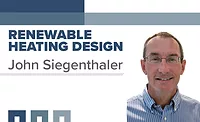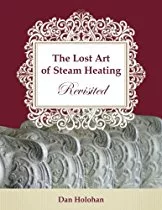Sweating The Details
No two hydronic heating systems are exactly the same. Even a routine job like a three-zone baseboard system gets installed 10 different ways by 10 different installers.
The key differences are usually in the details. Even if all 10 systems delivered the correct amounts of heat, some may be easier to service. One might use fewer pipe fittings for a neater appearance; still another might have slightly more accurate water temperature control.
This month I'll show you a few of the details that I've either seen in the field or had described to me. Most came from the minds of hydronic professionals who constantly look for ways to improve the systems they install
The Heat Stops Here
In the past, we've talked about thermal traps as a means of reducing heat migration into inactive portions of a hydronic system.One common application is the vertical drop-in piping between a boiler loop and distribution system when injection mixing is used. Another is the so-called "underslung return" of a secondary circuit just before it rejoins the primary loop. Here are a couple details pertaining to such traps:
- When creating an underslung thermal trap using rigid copper tubing, make the return bend using a baseboard tee and a street ell. Install a 1/8-inch MPT brass plug in the baseboard tee. The resulting assembly is shown in Figure 1.
This simple detail allows the underslung trap to be drained if ever necessary. It's also less expensive than installing an elbow, tee, female adapter, two pipe stubs and drain valve; just ask the guy who showed it to me, Harvey Youker of Undersun Construction.
- When using variable speed injection, mixing a thermal trap is essential in preventing heat migration from the boiler loop into the distribution system. One foot of vertical drop between the connections to the boiler loop and the distribution loop is considered an absolute minimum.
Here's a new twist (or should I say "bend") on the subject: How about using small diameter PEX or PEX-AL-PEX tubing for the injection riser/thermal trap piping? Make the transition from metal to plastic below the injection circulator and balancing valve as shown in Figure 2.
Figure 2
Keep the boiler loop piping as high as practical. Route the flexible tubing all the way down to floor level and then back up a short distance before teeing into the distribution loop. Keep things neatly arranged on the mechanical room wall using tubing clips.
This detail should allow several feet of vertical drop between the two loops. The low thermal conductivity of the plastic tubing (compared to metal pipe) further reduces heat migration.
Because the required injection flow rate in many residential (low temperature radiant) systems is only 1 to 2 gallons per minute, 1/2- or even
3/8-inch tubing can usually be used for the injection piping. The increased pressure drop of the small diameter tubing actually improves the rangeability of the variable speed injection system and reduces the throttling requirement of the balancing valve. Thanks to Jeff McGough of J.J. McGough & Associates for some "cool" thoughts on thermal traps.
Planting Your Bulbs
One method of water temperature control used in radiant panel heating systems relies on a two-way thermostatic valve to regulate hot water injection into the distribution circuit. These valves have a temperature-sensing bulb connected to the valve actuator via a capillary tube.Although the sensing bulb can be strapped to the outside of a tube and wrapped with insulation, the fastest and most accurate control occurs when the bulb is directly immersed in the water stream. This can be accomplished by mounting the bulb inside a tee downstream of the mixing point using a special gland fitting supplied with the valve.
Figure 3
Another possibility is to insert the bulb directly into one end of the supply manifold as shown in Figure 3. This ensures it will sense the true water temperature supplied to the circuits. On larger manifolds, especially if circuits are individually zoned, be sure the sensing bulb lies near the inlet end of the supply manifold.
Due to the limited length of the capillary tube, this detail is limited to jobs where the manifold is located within a few feet of the two-way valve.
And by the way, contrary to what an "architectural acquaintance" of mine thinks, capillary tubes can't be cut for the convenience of the installer, stapled in place and then rejoined with a wire nut!
Easy Expansions
How often does a customer tell you they may want to heat the attic - or the garage, or the basement - at some future time, and to plan their system accordingly? If you use primary/secondary piping, planning for a future secondary circuit is easy. Just make upa set of closely spaced tees, join them to short tube stubs and install a pair of threaded ball valves.Why threaded? Well, when it's time to connect that future circuit which would you rather do: drain the primary circuit so you can solder to sweat-type ball valves; or simply thread into the FPT valves, pipe the rest of the new circuit and open the valves to fill it.
It's also a good idea to put a couple of brass plugs in those ball valves until they're connected, just in case someone can't resist turning the handles to see if there really is scalding hot water on the other side.
Also remember that the future secondary circuit will create a temperature drop in the primary circuit while it operates. This will decrease the water temperature available to any downstream secondary circuits. The extent of the temperature drop depends on the rate heat is supplied to the new secondary circuit and the primary loop flow rate. It can be estimated using Formula 1:
Formula 1
Where:3Tprimary = temperature drop in primary loop due to operating secondary load (degrees F). Qsecondary = design heating load of secondary circuit (Btu/hr.).
fprimary = flow rate in primary loop (gpm).
490 = a constant for water (use 470 for 30 percent glycol, 450 for 50 percent glycol).
It's prudent to set a limit on the Btu/hr. capacity the future secondary circuit will require, calculate the associated temperature drop in the primary circuit and size the hardware in any downstream secondary circuits for the reduced water temperature.
Plentiful Purging
Ever tried purging a secondary piping circuit by blasting water around the primary loop? Doesn't work very well, does it?Figure 5
The closely spaced tees that prevent flow in the primary circuit from inducing flow in the secondary circuit actually work against you during purging. This can be remedied by installing a ball valve and drain valve on the return side of each secondary circuit just before it enters the downstream tee as shown in Figure 5.
To purge the secondary circuit, close the ball valve, connect a hose to the drain valve and open it. Then open the fast fill on the make-up water line. Water will race through the secondary circuit propelled by line pressure. Most of the air will be pushed out of the drain valve and hose after only a few seconds of purging.
A good air separator will gather and expel the rest once the system is put in operation. This purging detail should also be included in any distribution circuit that is coupled to a boiler loop via an injection mixing assembly (see Figure 5).
At least a couple of manufacturers now offer specialty valves that combine the functions of the ball and drain valves described. Typically they are available in pipe sizes up to 1 inch.
On larger circuits you will likely have to stick with the two-valve combination. You may even want to use a high capacity ball valve for the drain along with a barbed connector fitting and larger diameter hose, so as not to bottleneck the purging flow.
What ever valve(s) you use make sure each and every secondary circuit has its own purging capability. Your patience will thank you.
Flex Your PEX
Ever hook up panel radiators using PEX or other types of flexible tubing? One option is to install fittings that adapt the flexible tubing to the panel radiator connections where they're visible.This may or may not be acceptable depending on the appearance of the fittings, the "curvaceousness" of the tubing or the aesthetic tastes of the owners. This detail can also fall prey to repeated head butts from an upright vacuum cleaner.
Figure 6
An alternative, suggested by Howard Drum of Batavia Kill Plumbing & Heating, is to install iron pipe nipples at the radiator connections long enough to extend down through the floor, and then transition to flexible tubing as shown in Figure 6. They key is to leave enough flexible tubing in the floor joist cavity to allow the panel and piping to be lifted a few inches if ever necessary to service the fittings or paint the wall behind the radiator.
Wrench-tightened transition fittings can serve as unions in the event the panel ever has to be removed. Since the holes through the floor must be large enough to accommodate the transition fittings, be sure to install a couple of escutcheon plates on the iron pipe. Pre-paint the exposed iron pipe to match the radiator for a clean, professional-looking job.
Describe Your Details
Several of the details I've described were developed by dedicated hydronic installers who know every job holds possibilities for improvement over the last. Artisans who realize even minor refinements pay dividends on future systems.Many of you probably have at least one clever hydronic detail that saves time, improves the appearance of the job or solves a previous problem. Care to share it with other quality-conscious PM readers? If so fax me a description at 315/865-8903. I'll assemble the best for others to ponder in a future column.
In the meantime, remember that your professionalism is often evidenced by how you handle the details
Looking for a reprint of this article?
From high-res PDFs to custom plaques, order your copy today!








